4 Elements of a Stunning Fall Garden
Late summer is the perfect time to take stock and watch your landscape, as some plants will already begin turning or thinning out. In addition, if you want to do some editing, early to mid fall is probably the very best time to be planting — it’s much easier on you and the plants, while giving the new additions time to settle in before winter.
When I was 10, my family moved from Oklahoma to Minnesota. Not only was the physical process a shock to my system, but so too was the environmental change. Overwhelmingly hot, dry summers that could last five to six months were replaced by moodier swings in weather, with shorter summers and longer winters that seemed to go on and on, like a dentist appointment. But what struck me most that first autumn in Minnesota was the small woods in our new neighborhood. I’d visit it after school, transfixed by the rich musks of a spongy ground beneath me and the speckled, shifting rays of light punching through the canopy. It was magical. I witnessed a deeper sense of seasons in Minnesota. In essence fall became my favorite time of year precisely because it woke me to the natural environment in profound ways.
As a gardener I’ve let fall be my pot of gold at the end of the rainbow, so to speak. Almost every decision I make in spring is geared toward fall, from plant selection to placement. I’ve come to adore many species of asters, goldenrods and grasses, and have seen that perennials offer as much stunning leaf color as shrubs and trees. Let’s look at some design strategies that can provide a stunning fall garden from the ground level all the way to the treetops.
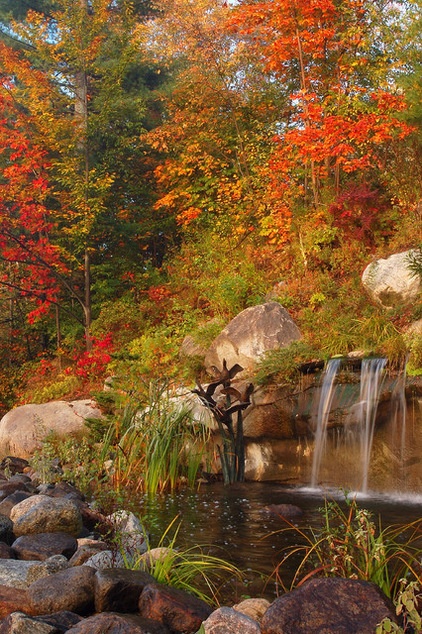
Diverse Structure
A lot of fall gardening seems to come down to trees — but there is opportunity for more. If the fall garden just comes from trees, we’re severely limiting our landscapes’ potential. Having a diverse structure supercharges autumn, and this means planting with trees, shrubs, perennials, grasses and ground covers.
I love my elm, willow and birch for yellow color, my maple for red, my oak for orange. Understory trees like Virginia chokecherry (Prunus virginiana) and serviceberry (Amelanchier spp) provide orange and red, respectively. Then there are various species of Viburnum, dogwood (Cornus spp), and Itea shrubs for all kinds of color. Sedum and prairie smoke (Geum triflorum) provide lovely hues at ground level. When we think beyond trees, we can create a more multidimensional garden that really knocks our socks off — and not just in October.
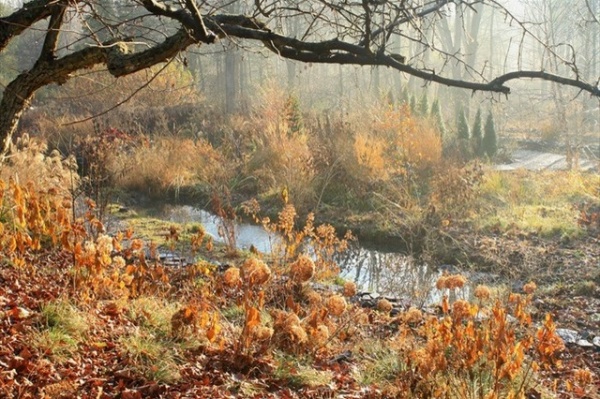
Look at the structure of this more naturalistic garden. A low overhanging tree limb in the front echoes the tall stand of trees in the background mist. Up front, low perennials have turned into their late-autumn rusts and browns, and behind the glassy water, grasses mix with dried stems of flowers. You’ll also notice some evergreen Thuja toward the right. That’s some nice structure, which creates a lot of visual interest, subtly shifting with each new day. Exciting!

Perennials turn lovely colors, too. Here is Liatris ligulistylis, which can take on rainbow shades one year and be bright yellow the next. It always depends on summer and fall rain, as well as a perfect blend of warm days and cool nights. The vertical structure pairs nicely with the wispier, more horizontal angles of grasses and sprawling shrubs.
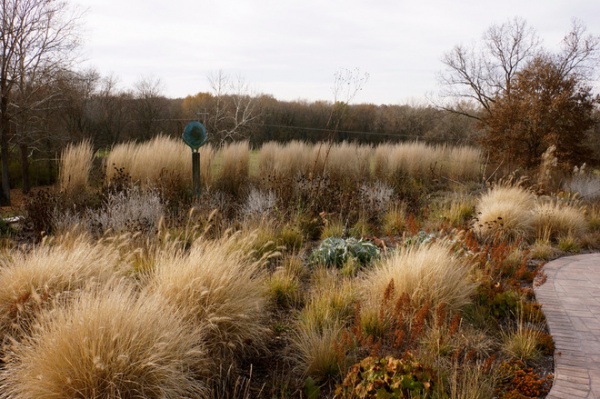
Contrasting Texture
Grasses provide easy texture and sound, and their colors often can’t be beat. Indian grass (Sorghastrum nutans) is a tall species that turns bright oranges, and bluestem goes for scarlets. Of course the seeds heads are often quite ornamental throughout the winter.
When you place grasses among perennials and even shrubs, you can create excitement, as the relatively sharp, woody stems mingle with the soft, undulating fingers of grass. It’s exciting to play around with this sort of textural juxtaposition.
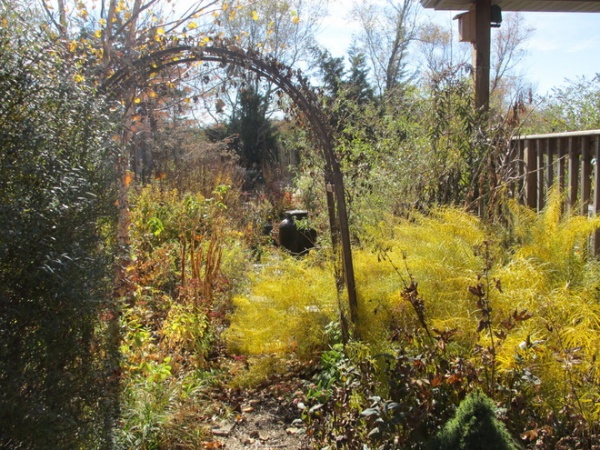
Grasses aren’t the only game in town. Here is Amsonia hubrichtii, which turns bright yellow before quickly diving into orange, rust and brown. Planted in drifts and en masse, it’s a stunning show that in this image really softens the hard lines of the deck and arbor.
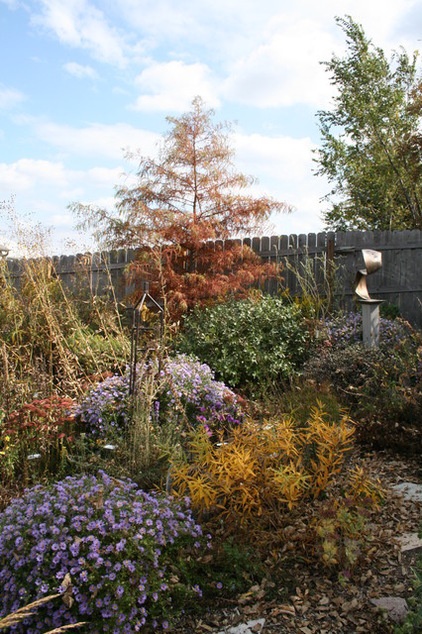
Late-fall blooms, like aromatic aster, can provide another element of texture. Notice how the short, shrubby asters lead up to the green Baptisia australis, then up to a young bald cypress (Taxodium distichum), and how the bloom and leaf textures are all different.
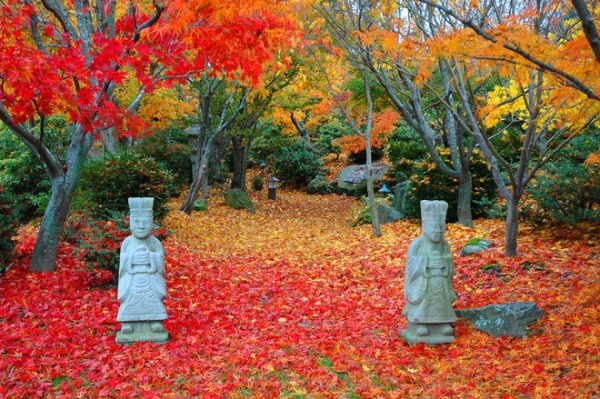
Negative Space
The use of negative space, in both landscapes and visual arts (like painting or sculpture), is a common design strategy. This is an area void of very much, if any, plant material; a place where the eye and body can take a break from the relative noise of flowers and leaves.
Here you can see a pathway beneath low trees, and how the eye is drawn deeper into the landscape due to the element of absence — that’s a metaphor for experiencing a garden if ever I saw one.
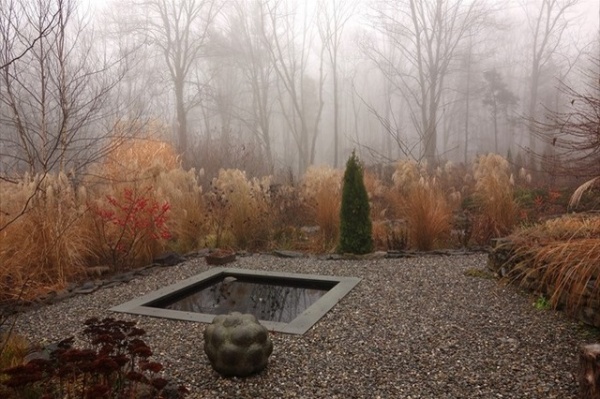
Ponds, pools and hardscapes can also create negative space. Here the reflecting pool and surrounding gravel at first seem to clash with the grass, perennials and tall trees farther back. But in reality this blank space helps us appreciate and enjoy — if not better focus on — the plants surrounding it. Without a space where we can rest our senses, we might soon be overwhelmed — it’s like catching your breath while running. Even just a bench can be an ornamental element that provides a visual and physical respite all at once.
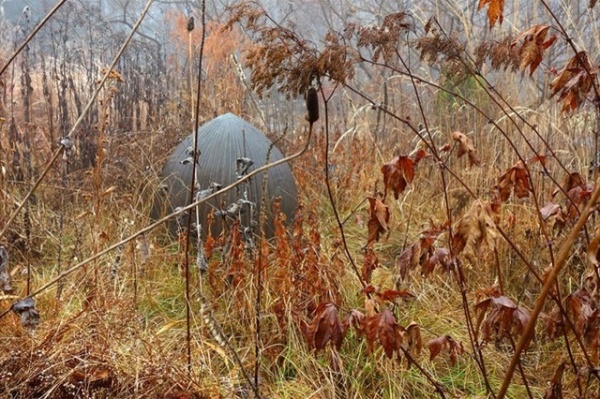
Sculpture
I’ve always been a fan of art in the garden, especially abstract art, which seems to help the eye settle while drawing it further into the landscape. If this sculpture had been a flower or a tree shape, I think I’d look right past it; instead, the juxtaposing, rounded shape plays against the straight stems of fall perennials, and this makes me look deeper and longer into the landscape. I know this sounds sort of Zen, but it’s true, don’t you think?
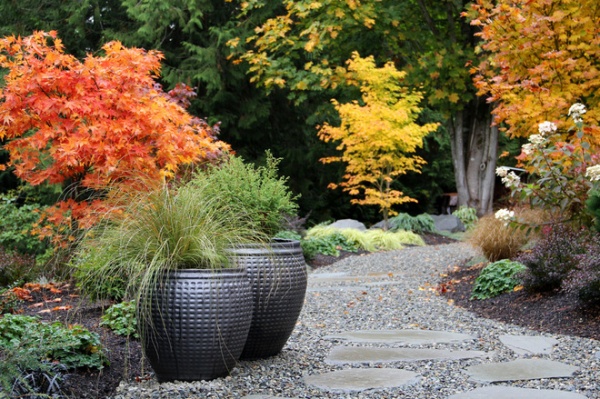
Even a few simple pots can provide an element of art, and sometimes at a more affordable price. Place them along a path or even along a border; experimenting by moving them around could open you to some design surprises and delightful serendipity you might not have experienced in the garden before.
See more of this fall garden
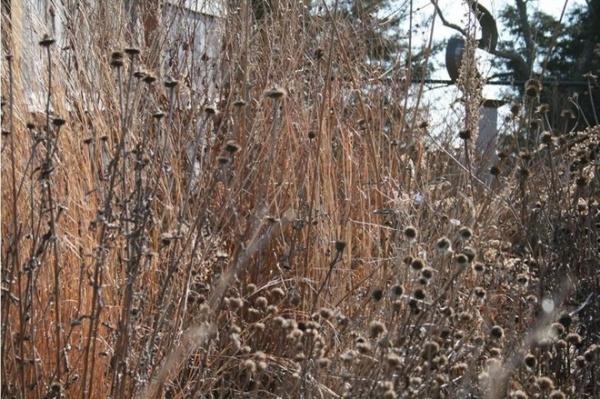
Ongoing Interest
Once the fall color show is over, texture and structure don’t end. Not by a long shot. Perennials, grasses and shrubs still have so much to offer — especially with ornamental seed heads. Wild senna (Senna hebecarpa), coneflowers (Echinacea spp), bush clover (Lespedeza spp), Joe Pye Weed (Eupatorium purpureum) and Baptisia are some flowering perennials whose seed heads are outstanding design elements in a fall and winter garden. What’s more, once the snow starts flying, you’ll be glad you left the garden up — it’s gorgeous. Of course, lots of wildlife will also thank you, from bees to butterflies to frogs, who all overwinter in hollow stems and under leaves.
More reasons not to clean up the fall garden
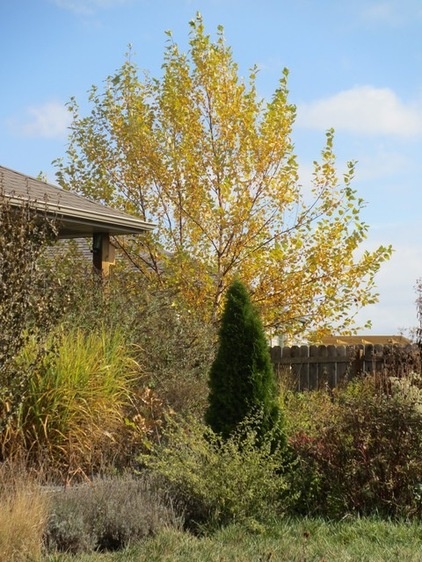
As you observe your garden’s transition from summer to fall, think about what structure, texture and negative space might be missing. Are the missing elements up high, in the middle or down low? Is one area dominated by grasses or shrubs and so seems a little too simple or drab? What would happen if you mix plant types? Where is fall color absent?
When you look out of the window in winter at the bones of the garden, where do you wish it had more places where the eye could rest? Where might a simple pot or sculpture help tie together a plant grouping or bring you deeper into the design? When spring rolls around and you can implement new ideas, you’ll be itching for fall to come around again.
More: Ways to enjoy your garden in fall












